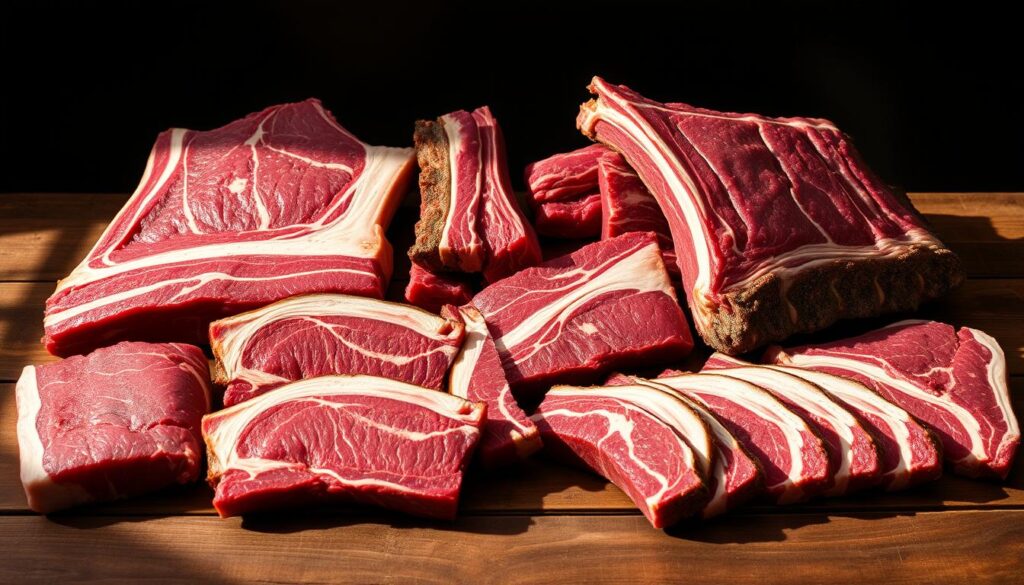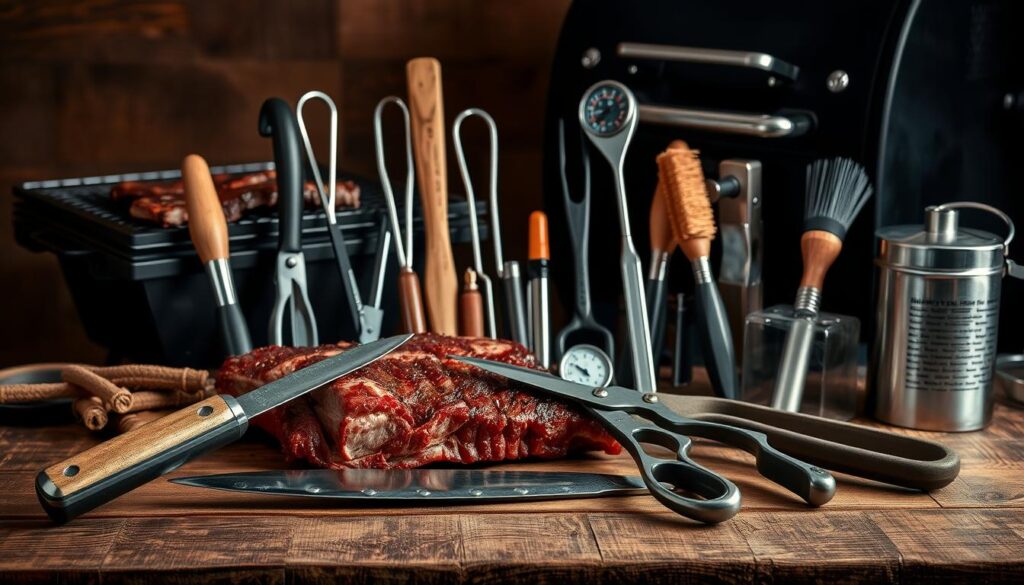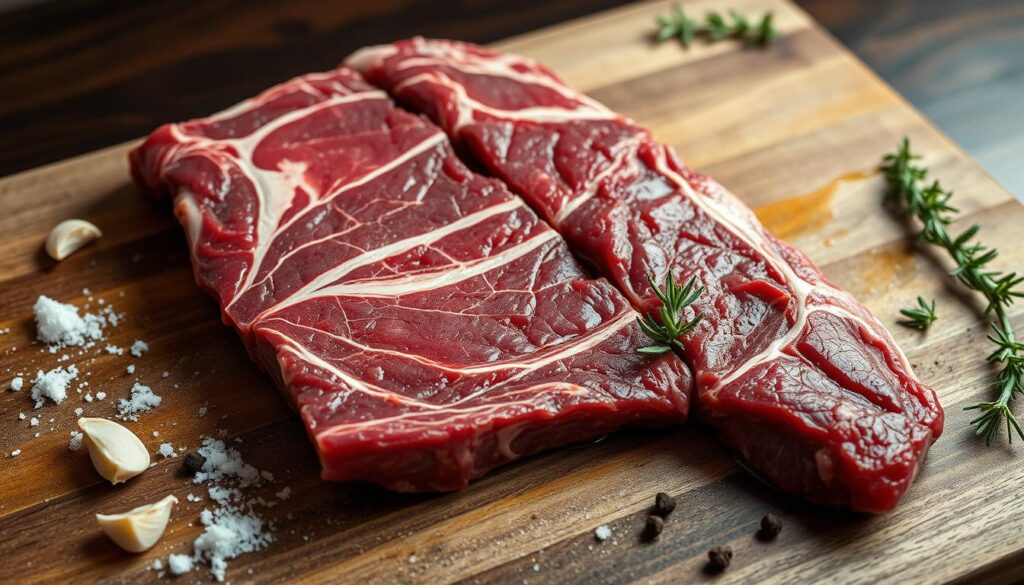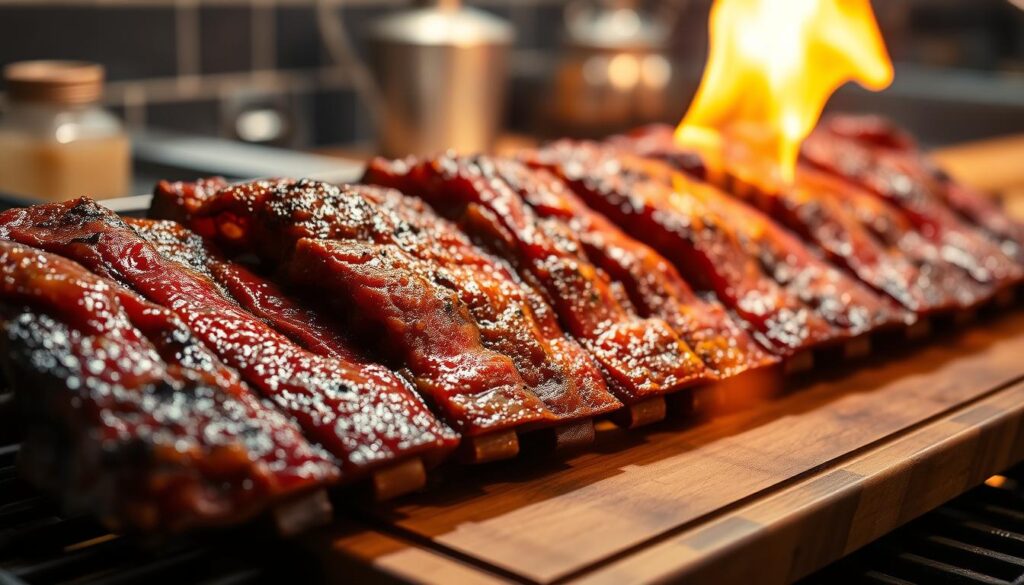Beef back ribs recipes are a backyard classic. Whether you prefer them grilled, braised, or smoked, this guide will walk you through the best cooking methods to unlock juicy, tender, and flavor-packed results. Barbecued ribs are more than just food; they’re a tradition passed down through generations. Aaron Franklin, a famous barbecue expert, says mastering smoked ribs takes passion, patience, and practice.
Cooking beef back ribs is more than just throwing meat on a grill. It’s about learning the detailed techniques that make ordinary cuts into amazing meals. Whether you’re a backyard cook or want to be a pitmaster, knowing the right cooking methods can make your barbecue better.
Each cooking method – grilling, braising, and smoking – brings its own flavors and textures. The trick is to know how to bring out the best in your beef back ribs. From slow smoking to quick grilling, you’ll learn the secrets to making ribs that are tender, tasty, and hard to resist.
Get ready for a cooking adventure that will change how you make beef back ribs. With the right skills and techniques, you’ll be serving ribs that are as good as those in a restaurant. Your family and friends will be impressed.
Understanding Different Types of Beef Ribs
Choosing the right cut of beef ribs is key to a great grilled ribs experience. Knowing the differences between various rib cuts helps you make the perfect beef ribs recipe. This suits your cooking style and taste.

Beef ribs have several distinct types, each with its own flavor and cooking method. Let’s look at the most popular cuts to boost your grilling skills.
Chuck Ribs: The Flavorful Choice
Chuck ribs are known for their rich flavor and marbling. They come from the shoulder area. These ribs offer:
- Intense beef flavor
- Higher fat content
- Excellent for low and slow cooking techniques
Plate Ribs: Smoking Perfection
Plate ribs are found below the chuck ribs. They are larger and have more meat. They are great for smoking because of their:
- Thick meat layers
- Robust connective tissue
- Ideal texture for long cooking processes
Selecting the Right Cut for Your Cooking Method
When making your beef ribs recipe, keep these tips in mind:
- For grilled ribs, choose chuck ribs with good marbling
- Opt for plate ribs when planning to smoke meat
- Inspect meat quality and fat distribution
Pro tip: Discuss your specific cooking plans with your local butcher to ensure you select the most suitable cut.
Understanding these differences can turn your grilled ribs into something amazing. You’ll impress family and friends with your cooking skills.
Essential Equipment and Tools for Rib Preparation

Preparing delicious beef ribs is more than just skill. You need the right tools to make your backyard cooking top-notch. Quality equipment will take your rib rub seasoning and marinade to the next level, ensuring tasty results every time.
Your essential toolkit for amazing ribs includes:
- Precision Thermometers: Digital meat thermometers guarantee perfect doneness
- Heavy-duty smokers or grills with temperature control
- Sturdy meat tongs and handling utensils
- Aluminum foil for wrapping and moisture retention
- Sharp boning knife for trimming
Investing in top-notch equipment lets you try out different marinades and rubs. A reliable smoker or grill is key for tender, flavorful ribs.
Pro tip: Quality tools are the secret ingredient to restaurant-worthy beef ribs at home.
Think about adding extras like meat claws for shredding, silicone brushes for marinades, and a good cutting board. These will round out your rib prep tools.
Preparing Beef Back Ribs for Cooking
Getting your beef spare ribs ready for cooking is key. The right steps can turn simple ribs into a dish that wows everyone. It will also make your taste buds happy.

Before you start cooking, you need to know a few important steps. These steps are crucial for your slow cooker ribs or grilled ribs to be perfect.
Removing the Membrane
The first step is to remove the tough membrane from the back of the ribs. This thin layer stops seasonings from getting into the meat. It can also make the ribs chewy.
- Use a butter knife to loosen the membrane’s edge
- Grip the membrane with a paper towel for better traction
- Pull the membrane off in one smooth motion
Trimming and Seasoning
Trimming the ribs is important for even cooking and better flavor. Look for any extra fat or uneven parts that might burn.
| Trimming Technique | Purpose |
|---|---|
| Remove hard fat | Improves meat texture |
| Trim uneven edges | Ensures consistent cooking |
| Cut between bones if needed | Creates more manageable portions |
Marinade and Rub Options
How you season your ribs can change their flavor a lot. Some like a simple salt and pepper rub. Others make complex spice blends.
- Classic Rub: Kosher salt, black pepper, paprika
- Sweet and Spicy: Brown sugar, chili powder, garlic powder
- BBQ Style: Smoked paprika, cumin, cayenne pepper
Whether you’re slow cooking or grilling, these steps will help make your beef back ribs delicious.
The Art of Smoking Beef Ribs
Smoking beef ribs turns simple meat into a delicious treat. It’s all about finding the right mix of heat, time, and skill. Making perfect smoked ribs is a true challenge for any pitmaster.
To smoke ribs well, follow these key steps:
- Select high-quality beef back ribs
- Choose the right wood for smoking
- Maintain consistent temperature
- Monitor smoke levels carefully
The 3-1-1 method is a favorite for tender, tasty ribs. This method breaks down the smoking process into three distinct stages:
| Stage | Duration | Technique |
|---|---|---|
| Initial Smoking | 3 hours | Smoke uncovered to develop rich flavor |
| Wrapping | 1 hour | Wrap in foil to tenderize meat |
| Finishing | 1 hour | Unwrapped to create perfect bark |
“Smoking ribs is an art that demands respect for the meat and mastery of fire.” – BBQ Pitmaster
Choosing the right wood is key for great smoked ribs. Hickory, oak, and mesquite add unique flavors. Remember, smoking is all about patience. Slow cooking makes tough meat tender and full of flavor.
Mastering the Grilling Process
Grilling beef ribs is an art that needs precision and heat management skills. Your beef ribs recipe will only shine when you master the fundamental techniques of grilling. Professional pitmasters know that successful grilled ribs depend on careful temperature control and strategic heat application.
The secret to exceptional grilled ribs lies in understanding different heat methods and their unique impacts on meat texture and flavor. Your approach can make the difference between tough, dry meat and a tender, succulent dish.
Temperature Control Techniques
Controlling grill temperature is critical for perfect beef ribs. Start by preheating your grill to the right zone:
- Low and slow: 225-250°F for tender meat
- Medium heat: 275-300°F for balanced cooking
- High heat: Brief searing at 350-400°F for caramelization
Direct vs Indirect Heat Methods
Each heat method offers unique advantages for your beef ribs recipe:
- Direct Heat: Best for creating a crispy exterior
- Indirect Heat: Ideal for even, slow cooking
Timing and Doneness Indicators
Knowing when your grilled ribs are perfectly cooked requires keen observation. Look for these signs:
- Meat pulls back from bone ends
- Internal temperature reaches 195-203°F
- Meat feels tender when probed
Remember, patience transforms good grilled ribs into an extraordinary culinary experience.
Braising Techniques for Tender Results
Braising turns tough beef spare ribs into tender, fall-off-the-bone meat. It uses low, slow heat to break down connective tissues. This method works well in slow cookers or traditional ovens, ensuring delicious results.
To begin, choose high-quality beef spare ribs with good marbling. The main steps are:
- Searing ribs to develop rich, deep flavor
- Selecting flavorful braising liquids like beef broth or red wine
- Cooking at low temperatures for extended periods
Slow cooker ribs are perfect for braising. Make sure the liquid covers about one-third of the meat. This allows steam to tenderize the ribs. Pro tip: Add aromatics like garlic, onions, and herbs to enhance the braising liquid’s complexity.
“The secret to perfect braised ribs is patience and low, consistent heat.” – Professional Chef
Braising temperatures are between 275-325°F. This gentle heat makes the ribs incredibly succulent. The meat will easily pull away from the bone.
- Oven braising: Use a heavy Dutch oven with a tight-fitting lid
- Slow cooker method: Cook on low for 6-8 hours
After braising, reduce the remaining liquid to create a rich, flavorful sauce. This sauce will perfectly complement your tender ribs.
The 3-1-1 Method for Perfect Ribs
Mastering beef back ribs needs precision and skill. The 3-1-1 method is a game-changer for delicious smoked ribs. They become tender, flavorful, and always taste great.
This method divides the smoking process into three stages. It makes your beef back ribs go from tough to tender. Knowing each stage is key to getting restaurant-quality ribs at home.
Step-by-Step Smoking Process
The 3-1-1 method has three main stages:
- First 3 Hours: Initial smoking at a low temperature
- Next 1 Hour: Wrapped in foil to keep moisture in
- Final 1 Hour: Unwrapped to get a crispy outside
Temperature Management Techniques
Keeping the temperature steady is vital when smoking beef back ribs. Your smoker should stay between 225-250°F. Use a meat thermometer to check both the smoker and meat temperatures.
Wrapping and Finishing Techniques
Wrapping in aluminum foil during the second stage keeps moisture in and speeds up cooking. When you unwrap for the last hour, you get a tasty bark and better flavor.
Pro tip: Patience is key when preparing beef back ribs using the 3-1-1 method.
Sauces, Glazes, and Finishing Touches
To take your beef back ribs from great to amazing, focus on the right rib marinade and seasoning. The perfect sauce can turn your meat into a dish that wows everyone. It’s a must for barbecue lovers.
Starting a memorable rib experience means mastering sauces and glazes. Your seasoning is the base, but the final touches make it pop. Here are some tips for perfecting your ribs:
- Choose a balanced rib marinade that complements the meat’s natural flavors
- Apply sauces during the final stages of cooking to prevent burning
- Experiment with sweet, tangy, and spicy flavor profiles
Timing is key when using glazes. Brush your sauce during the last 15-20 minutes of cooking. This creates a caramelized, sticky exterior. It keeps moisture in and boosts flavor.
| Sauce Type | Flavor Profile | Best Used With |
|---|---|---|
| Kansas City-Style | Sweet and Thick | Smoked Beef Back Ribs |
| Texas-Style | Spicy and Tangy | Grilled Ribs |
| Carolina Vinegar | Sharp and Acidic | Braised Ribs |
Your seasoning should match the sauce for a perfect taste. Feel free to create your own blend. It should show off your cooking style.
Conclusion
Cooking beef back ribs is a journey that requires skill, patience, and passion. You can grill, smoke, or braise them, each way leading to delicious barbecued ribs. Your knowledge of different cuts and techniques will help you succeed in the kitchen.
Getting good at cooking beef back ribs takes time and trying new things. Even if your first tries don’t turn out right, keep going. Every time you cook, you learn more about controlling temperatures and finding your favorite flavors.
Your adventure with beef back ribs is just starting. You’ve learned about different types of ribs and how to smoke and grill them. Keep learning, trusting your taste, and trying new things to make your ribs stand out.
Great cooking is about passion, creativity, and sharing tasty meals with loved ones. With what you’ve learned, you can make amazing beef back ribs at home. So, get ready to grill, believe in yourself, and enjoy the fruits of your labor.
FAQ
What are the main differences between chuck ribs and plate ribs?
What equipment do I need to cook beef back ribs at home?
How do I remove the membrane from beef back ribs?
What is the 3-1-1 method for cooking beef ribs?
What are the best wood types for smoking beef ribs?
How long should I cook beef back ribs?
What’s the best way to season beef back ribs?
How can I tell when beef ribs are done?
Can I cook beef back ribs in a slow cooker?
What are some good sauce options for beef back ribs?
There are no reviews yet. Be the first one to write one.



